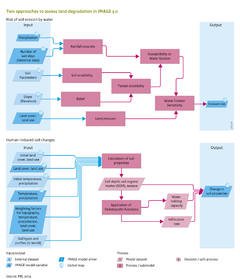Land degradation/Description: Difference between revisions
Jump to navigation
Jump to search
No edit summary |
No edit summary |
||
| Line 32: | Line 32: | ||
Comparison of the calculation above and the GLASOD degradation status maps by [[Oldeman et al., 1991|Oldeman et al. (1991)]] shows maximum correspondence with use of the classification in Table 7.5.2. This classification can be used as a guide in analysing the water erosion sensitivity indicator. | Comparison of the calculation above and the GLASOD degradation status maps by [[Oldeman et al., 1991|Oldeman et al. (1991)]] shows maximum correspondence with use of the classification in Table 7.5.2. This classification can be used as a guide in analysing the water erosion sensitivity indicator. | ||
<table> | |||
<caption>Classification of the Water Erosion Sensitivity Index</caption> | |||
<tr> | |||
<th>Water Erosion Sensitivity Index</th> | |||
<th>GLASOD soil degradation caused by water erosion</th> | |||
</tr> | |||
<tr> | |||
<td>< 0.15</td> | |||
<td>no/low</td> | |||
</tr> | |||
<tr> | |||
<td>0.15 - 0.30</td> | |||
<td>moderate</td> | |||
</tr> | |||
<tr> | |||
<td>0.30 - 0.45</td> | |||
<td>high</td> | |||
</tr> | |||
<tr> | |||
<td>> 0.45</td> | |||
<td>very high</td> | |||
</tr> | |||
</table> | |||
}} | }} | ||
Revision as of 12:41, 18 May 2014
Parts of Land degradation/Description
| Component is implemented in: |
|
| Related IMAGE components |
| Projects/Applications |
| Models/Databases |
| Key publications |
| References |
